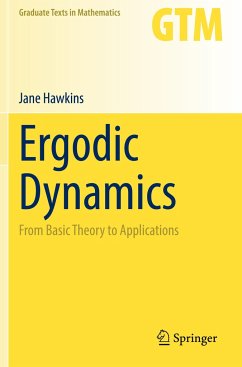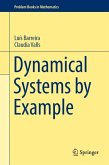This textbook provides a broad introduction to the fields of dynamical systems and ergodic theory. Motivated by examples throughout, the author offers readers an approachable entry-point to the dynamics of ergodic systems. Modern and classical applications complement the theory on topics ranging from financial fraud to virus dynamics, offering numerous avenues for further inquiry.
Starting with several simple examples of dynamical systems, the book begins by establishing the basics of measurable dynamical systems, attractors, and the ergodic theorems. From here, chapters are modular and can be selected according to interest. Highlights include the Perron-Frobenius theorem, which is presented with proof and applications that include Google PageRank. An in-depth exploration of invariant measures includes ratio sets and type III measurable dynamical systems using the von Neumann factor classification. Topological and measure theoretic entropy are illustrated and compared in detail, with an algorithmic application of entropy used to study the papillomavirus genome. A chapter on complex dynamics introduces Julia sets and proves their ergodicity for certain maps. Cellular automata are explored as a series of case studies in one and two dimensions, including Conway's Game of Life and latent infections of HIV. Other chapters discuss mixing properties, shift spaces, and toral automorphisms.
Ergodic Dynamics unifies topics across ergodic theory, topological dynamics, complex dynamics, and dynamical systems, offering an accessible introduction to the area. Readers across pure and applied mathematics will appreciate the rich illustration of the theory through examples, real-world connections, and vivid color graphics. A solid grounding in measure theory, topology, and complex analysis is assumed; appendices provide a brief review of the essentials from measure theory, functional analysis, and probability.
Starting with several simple examples of dynamical systems, the book begins by establishing the basics of measurable dynamical systems, attractors, and the ergodic theorems. From here, chapters are modular and can be selected according to interest. Highlights include the Perron-Frobenius theorem, which is presented with proof and applications that include Google PageRank. An in-depth exploration of invariant measures includes ratio sets and type III measurable dynamical systems using the von Neumann factor classification. Topological and measure theoretic entropy are illustrated and compared in detail, with an algorithmic application of entropy used to study the papillomavirus genome. A chapter on complex dynamics introduces Julia sets and proves their ergodicity for certain maps. Cellular automata are explored as a series of case studies in one and two dimensions, including Conway's Game of Life and latent infections of HIV. Other chapters discuss mixing properties, shift spaces, and toral automorphisms.
Ergodic Dynamics unifies topics across ergodic theory, topological dynamics, complex dynamics, and dynamical systems, offering an accessible introduction to the area. Readers across pure and applied mathematics will appreciate the rich illustration of the theory through examples, real-world connections, and vivid color graphics. A solid grounding in measure theory, topology, and complex analysis is assumed; appendices provide a brief review of the essentials from measure theory, functional analysis, and probability.
"This is a stylish and easy-to-read exposition of some major aspects of current ergodic theory. ... I would strongly recommend this book for someone wishing to understand the themes of modern ergodic theory and dynamical systems, and certainly as a source for teaching advanced courses in these areas. It also makes interesting reading for current researchers." (A. H. Dooley, SIAM Review, Vol. 64 (3), September, 2022)
"A book like this one is a very useful tool to introduce this subject, in a didactic way, for students and young researchers ... . The book is intended for an introductory course on the main ideas and examples in ergodic theory ... using some classical and current applications. A solid grounding in measure theory, topology, and complex analysis will make the book readily accessible. There are exercises given at the end of every chapter, including the appendices." (Elismar daRosa Oliveira, Mathematical Reviews, April, 2022)
"A book like this one is a very useful tool to introduce this subject, in a didactic way, for students and young researchers ... . The book is intended for an introductory course on the main ideas and examples in ergodic theory ... using some classical and current applications. A solid grounding in measure theory, topology, and complex analysis will make the book readily accessible. There are exercises given at the end of every chapter, including the appendices." (Elismar daRosa Oliveira, Mathematical Reviews, April, 2022)








